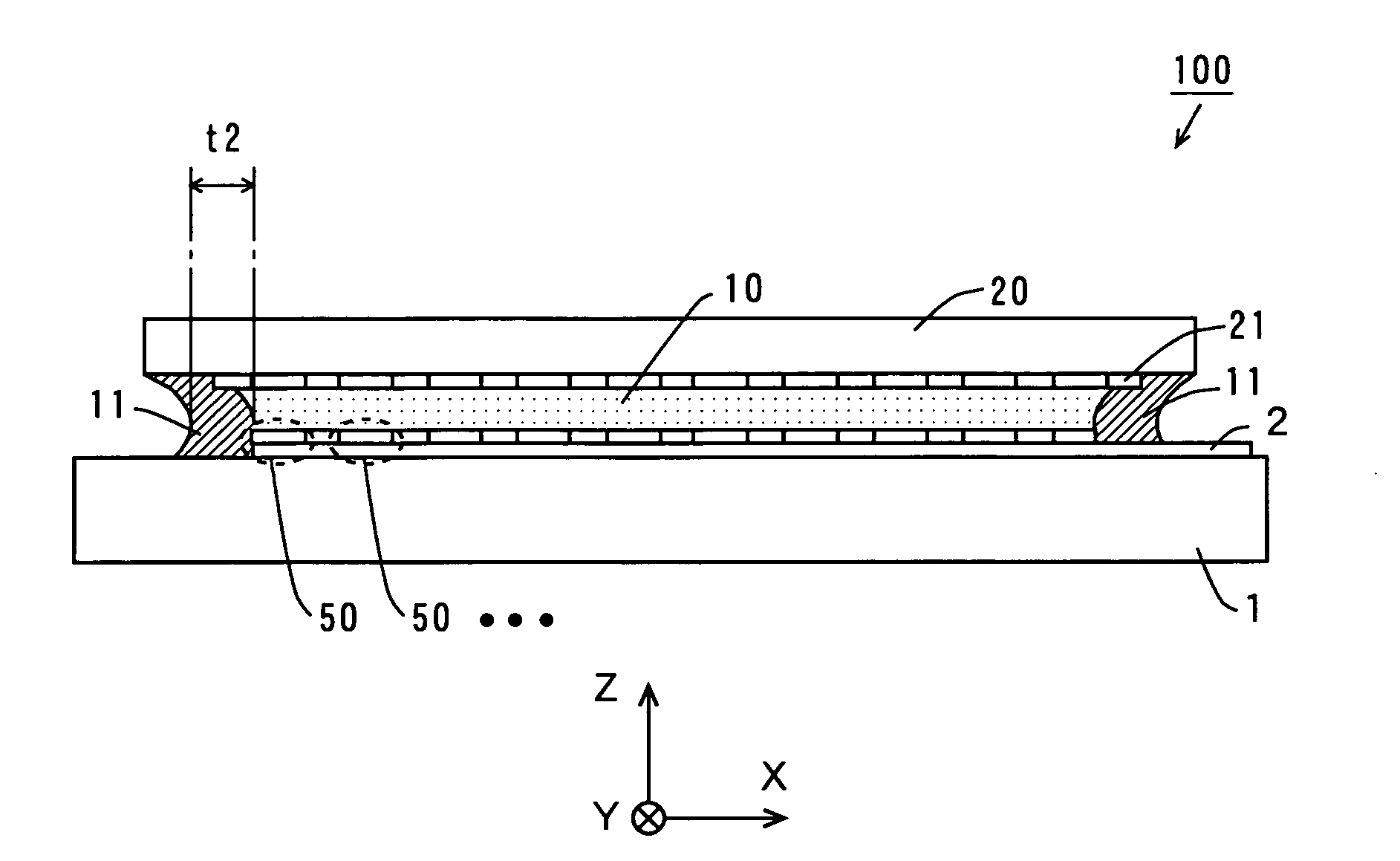Organic electroluminescent device and method for manufacturing same
a technology of electroluminescent devices and organic materials, applied in the direction of discharge tubes/lamp details, discharge tubes luminescnet screens, electric discharge lamps, etc., can solve the problems of organic material itself deteriorating, the interface between a metal electrode and an organic layer may deteriorate, and the device is extremely sensitive to moisture, so as to prevent the invasion of moisture
- Summary
- Abstract
- Description
- Claims
- Application Information
AI Technical Summary
Benefits of technology
Problems solved by technology
Method used
Image
Examples
first embodiment
[0068]FIG. 1 (a) is a schematic cross section of an organic EL apparatus according to a first embodiment, and FIG. 1 (b) is a magnified view of a portion of the organic EL apparatus of FIG. 1 (a). The organic EL apparatus 100 in the first embodiment has a top emission structure whereby light is extracted through an upper surface side.
[0069] In the organic EL apparatus 100 of FIG. 1 (a), a plurality of organic EL devices 50 are arranged in matrix form on a substrate 1. Each organic EL device 50 forms a pixel. For a passive matrix type, a glass substrate is used as the substrate 1, and for an active matrix type, a TFT substrate made of a glass substrate having a plurality of TFTs (Thin Film Transistors) and planarization layers thereon is used as the substrate 1.
[0070] Three directions perpendicular to one another are herein defined as X, Y, and Z directions, respectively. The X and Y directions are parallel to a surface of the substrate 1, and the Z direction is vertical to the sur...
second embodiment
[0101]FIG. 2 is a schematic cross section of an organic EL apparatus according to a second embodiment. The organic EL apparatus 100 in the second embodiment is configured similarly to the organic EL apparatus 100 in the first embodiment, and fabricated by a similar method to that of the first embodiment except the following.
[0102] The width t2 of a sealing agent 11 over the outer peripheral portion on the substrate 1 (the dimension parallel to a surface of the substrate 1) is formed to have a thickness greater than that of the width t1 (about 1 to 5 mm) of the sealing agent 11 in the first embodiment. The width t2 of the sealing agent 11 is about 2 to 10 mm. In this embodiment, the sealing agent 11 is formed so as to surround the plurality of organic EL devices 50. In other words, the outer periphery of the portion on the substrate 1 is covered by the single layer of sealing agent 11, with the sealing agent 11 being in contact with the organic EL devices 50 on the outer periphery. ...
third embodiment
[0103] An organic EL apparatus 100 according to a third embodiment is configured similarly to that of FIG. 2, and fabricated by a similar method to that of the first embodiment except the following.
[0104] A material containing a filler and a desiccant is used for a sealing agent 11 over the outer peripheral portion on the substrate 1. The desiccant added to the sealing agent 11 includes chemical absorbents such as calcium oxide, calcium sulfate, calcium chloride, barium oxide, and strontium oxide or physical absorbents such as activated carbon, silica gel, and zeolite. A material mentioned in the first embodiment is used for the sealing agent 11.
[0105] The addition of a desiccant to the sealing agent 11 allows the absorption of moisture contained in the sealing agent 11. This prevents the invasion of moisture to organic EL devices 50 still more sufficiently.
PUM
 Login to View More
Login to View More Abstract
Description
Claims
Application Information
 Login to View More
Login to View More - R&D
- Intellectual Property
- Life Sciences
- Materials
- Tech Scout
- Unparalleled Data Quality
- Higher Quality Content
- 60% Fewer Hallucinations
Browse by: Latest US Patents, China's latest patents, Technical Efficacy Thesaurus, Application Domain, Technology Topic, Popular Technical Reports.
© 2025 PatSnap. All rights reserved.Legal|Privacy policy|Modern Slavery Act Transparency Statement|Sitemap|About US| Contact US: help@patsnap.com



